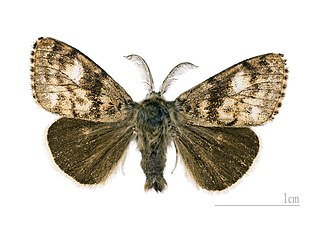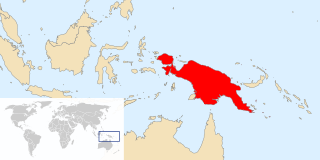
Nepticulidae is a family of very small moths with a worldwide distribution. They are characterised by eyecaps over the eyes. These pigmy moths or midget moths, as they are commonly known, include the smallest of all living moths, with a wingspan that can be as little as 3 mm in the case of the European pigmy sorrel moth, but more usually 3.5–10 mm. The wings of adult moths are narrow and lanceolate, sometimes with metallic markings, and with the venation very simplified compared to most other moths.
Urodidae or "false burnet moths" is a family of insects in the lepidopteran order, representing its own superfamily, Urodoidea, with three genera, one of which, Wockia, occurs in Europe.
Agathiphaga is a genus of moths in the family Agathiphagidae, known as kauri moths. This caddis fly-like lineage of primitive moths was first reported by Lionel Jack Dumbleton in 1952, as a new genus of Micropterigidae.

The orange leaf-nosed bat is a bat in the family Hipposideridae. It is the only living species in the genus Rhinonicteris which is endemic to Australia, occurring in the far north and north-west of the continent. They roost in caves, eat moths, and are sensitive to human intrusion.
Heliosia is a genus of moths in the family Erebidae.

The Thyatirinae are a subfamily of the moth family Drepanidae with about 200 species described. Until recently, most classifications treated this group as a separate family called Thyatiridae.
Heliosia alba is a moth of the family Erebidae. It was described by George Hampson in 1914. It is found in Taiwan.
Heliosia atriplaga is a moth of the family Erebidae. It was described by George Hampson in 1914. It is found on the Loyalty Islands in the south-west Pacific.
Heliosia charopa is a moth of the family Erebidae. It was described by Turner in 1904. It is found in Australia, where it has been recorded from Queensland.
Heliosia crocopera is a moth of the family Erebidae. It was described by George Hampson in 1900. It is found on New Guinea.
Neoscaptia eurochrysa is a moth of the subfamily Arctiinae. It was described by George Hampson in 1914. It is found on New Guinea.
Heliosia jucunda is a moth of the family Erebidae. It was described by Francis Walker in 1854. It is found in the Australian states of Queensland and New South Wales.
Heliosia micra is a moth of the family Erebidae. It was described by George Hampson in 1903. It is found in Australia.
Heliosia monosticta is a moth of the family Erebidae. It was described by George Hampson in 1900. It is found on Borneo. The habitat consists of lowland forests, dry heath forests and coastal scrubs.
Heliosia perichares is a moth of the family Erebidae. It was described by Turner in 1944. It is found in Australia, where it has been recorded from Queensland and New South Wales.
Heliosia punctinigra is a moth of the family Erebidae. It was described by Rudolf van Eecke in 1920. It is found on Java in Indonesia.
Heliosia rufa is a moth of the family Erebidae. It was described by Leech in 1890. It is found in the Russian Far East (Primorye) and China.
Heliosia suffusus is a moth of the family Erebidae. It was described by Rothschild in 1913. It is found in New Guinea.





